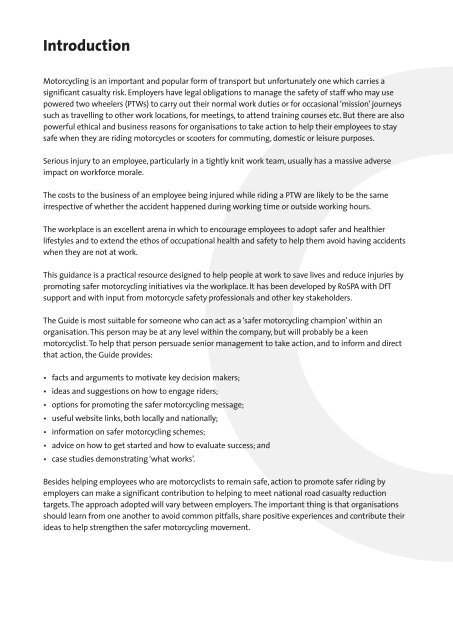Safer Motorcycling Through Work - Network - Motorcycle Action Group
Safer Motorcycling Through Work - Network - Motorcycle Action Group
Safer Motorcycling Through Work - Network - Motorcycle Action Group
You also want an ePaper? Increase the reach of your titles
YUMPU automatically turns print PDFs into web optimized ePapers that Google loves.
Introduction<br />
<strong>Motorcycling</strong> is an important and popular form of transport but unfortunately one which carries a<br />
significant casualty risk. Employers have legal obligations to manage the safety of staff who may use<br />
powered two wheelers (PTWs) to carry out their normal work duties or for occasional ‘mission’ journeys<br />
such as travelling to other work locations, for meetings, to attend training courses etc. But there are also<br />
powerful ethical and business reasons for organisations to take action to help their employees to stay<br />
safe when they are riding motorcycles or scooters for commuting, domestic or leisure purposes.<br />
Serious injury to an employee, particularly in a tightly knit work team, usually has a massive adverse<br />
impact on workforce morale.<br />
The costs to the business of an employee being injured while riding a PTW are likely to be the same<br />
irrespective of whether the accident happened during working time or outside working hours.<br />
The workplace is an excellent arena in which to encourage employees to adopt safer and healthier<br />
lifestyles and to extend the ethos of occupational health and safety to help them avoid having accidents<br />
when they are not at work.<br />
This guidance is a practical resource designed to help people at work to save lives and reduce injuries by<br />
promoting safer motorcycling initiatives via the workplace. It has been developed by RoSPA with DfT<br />
support and with input from motorcycle safety professionals and other key stakeholders.<br />
The Guide is most suitable for someone who can act as a ‘safer motorcycling champion’ within an<br />
organisation. This person may be at any level within the company, but will probably be a keen<br />
motorcyclist. To help that person persuade senior management to take action, and to inform and direct<br />
that action, the Guide provides:<br />
• facts and arguments to motivate key decision makers;<br />
• ideas and suggestions on how to engage riders;<br />
• options for promoting the safer motorcycling message;<br />
• useful website links, both locally and nationally;<br />
• information on safer motorcycling schemes;<br />
• advice on how to get started and how to evaluate success; and<br />
• case studies demonstrating ‘what works’.<br />
Besides helping employees who are motorcyclists to remain safe, action to promote safer riding by<br />
employers can make a significant contribution to helping to meet national road casualty reduction<br />
targets. The approach adopted will vary between employers. The important thing is that organisations<br />
should learn from one another to avoid common pitfalls, share positive experiences and contribute their<br />
ideas to help strengthen the safer motorcycling movement.


